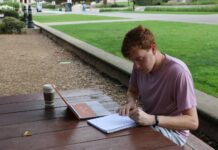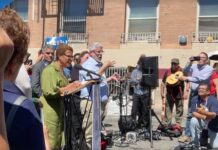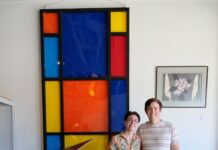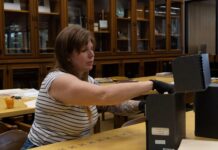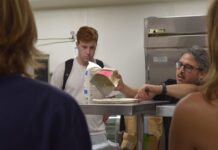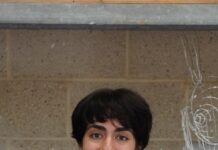Author: Rachel Stober
KNITTING NATION hits Occidental
The bell tower chimes as students hurry to class Wednesday, Nov. 6. But even the last stragglers stop and stare at the blue fabric cascading down the stairs between Johnson and Fowler Halls, draping off the rooftops and dripping into the quad, intertwined like a thick yarn net. When students finally tear their eyes away from the spectacle and scurry off to class, the corridor is left silent except for the quiet whirring and clicking of the manually operated knitting machines that feed the growing river of yarn.
Manning the contraptions is a small army of about a dozen students from Art History and Visual Arts (AHVA) Professor Mary Beth Heffernan’s “Advanced Projects in Interdisciplinary Arts” class, clad in short white jumpsuits and white Doc Martins (donated for the project). Heffernan and her students have been preparing for over two months to facilitate the West Coast premier of artist-in-residence Liz Collins’ ongoing project, KNITTING NATION. This is the 12th site-specific installment of KNITTING NATION, which started on Governor’s Island in New York in 2005 and has since traveled around the world before coming to Occidental, colored blue to represent Occidental’s “H2Oxy” theme for the school year.
By the end of the day, students must confront the giant art installation, as its far-reaching yarn tentacles pose a substantial obstacle to walking between Fowler and Johnson.
“It’s perfect,” Collin said. “It was all very strategic – I knew this was the center of campus, and I knew that it was a high traffic area, and I knew that people wouldn’t have to look for it. It would just be there in their face, and I wanted that because it makes it more accessible.”
Collins, an internationally renowned textile artist and fashion designer, had never used non-trained knitters to create installations before arriving at Occidental. Although Collins emphasizes that the project is open to interpretation, she envisions it as a behind-the-scenes look at the connection between fashion and its production – manufacturing, human labor, machines and trade. She is quick to point out that this is obviously an art project and not what an actual textile factory looks like (she has visited many around the world), but still sees it as a valuable platform to communicate the emotions and energy of the processes.
“It’s the same kind of dance that a person is doing with the machine to make a piece of fabric: lots of meticulous and physically demanding labor involved,” Collins said. “So it’s kind of laying bare that reality of labor and transforming material from one state to another and the relationship that a body has to a piece of equipment in a situation where repetitive motion is required to make something for human use.”
For students outside of the department, the project provided an unavoidable opportunity to interact with art. Sociology major Kate Handley (junior) said she appreciated the installations slightly “aggressive” location.
“The art department generally stays a little more isolated, and I think that installations like this are a great way to engage the whole community and show off all the cool projects they do,” Handley said.
According to Heffernan, however, events like this are far from routine and involve extensive advanced and “unsexy” administrative planning to make happen. The installation evolved with help all over campus, from the Center for Community Based Learning to Facilities and Campus Safety. The Kathryn Caine Wanlass Charitable Foundation, which supports artist residencies at undergraduate institutions, provided a $91,225 grant to support the project.
“I haven’t done anything this ambitious at Oxy in my 11 years here and to my knowledge we haven’t had a major art installation like this at Oxy before,” Heffernan said. “I was just so pleased with the way the students threw themselves into it with heart and body and mind and spirit and they really gave themselves to the project.”
Studio Art major Hannah Rindlaub (junior) says this was her first hands-on experience with an art installation.
“I have never done anything that I could ever even call close to this,” Rindlaub said. “This is really cool for me, ‘cause how many people can say they know how to work an industrial knitting machine and spent a day – seven hours straight – knitting?”
This article has been archived, for more requests please contact us via the support system.
![]()







